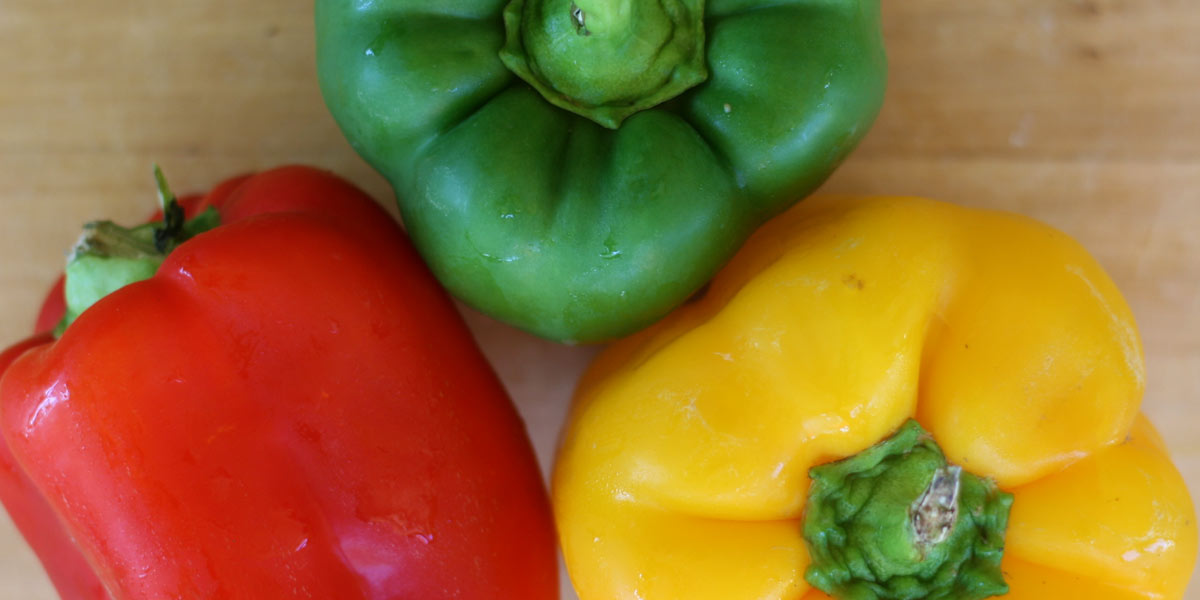Bell Peppers
Bell peppers are a crunchy, sweet, and colorful vegetable ranging in shades of green, red, yellow, orange, purple, and black. They’re the perfect veg for dipping into hummus or cashew cheese, taking on the go, sautéing, grilling, stuffing, roasting, and more. I love using bell peppers in omelets, on pasta, in collard green wrap, and in crunchy chopped salads.
- Bell peppers are an excellent source of carotenoids and contain over 30 different types. All these plant-powered compounds do amazing things for your body including protection from free radical damage, immune system support, and cancer protection benefits.
- Make sure your bell peppers are nice and ripe before sticking them in your salad. Studies have shown that the Vitamin C and carotenoid content increases as bell peppers ripen, which means you’ll reap more antioxidant goodness. How do you know if a pepper is ripe? The bell pepper will have a deep and rich color, feel heavy for its size, and remain firm while yielding slightly to a light squeeze.
- Just one cup of sliced bell peppers provides around 150% of the daily-recommended value of Vitamin C, which is necessary for collagen production for beautiful skin, immune system support, and protection from free radicals that damage cells.
- Bell peppers contain plenty more goodness too including Vitamin A, B6, E, B2, B3, folate, fiber, and manganese.
Vegukate Tips:
Try to buy organic bell peppers, as conventionally grown peppers are usual culprits on EWG’s Dirty Dozen. In fact, they’ve found 53 pesticide residues on bell peppers including some probable carcinogens, hormone disruptors, and honeybee toxins. Go organic on this one!
Select peppers that feel firm and heavy and avoid peppers with mushy, wrinkly skin and brown spots. Store bell peppers in a plastic bag, or in the vegetable crisper in your refrigerator where they should keep for 5 days.
-
Tomato and Cucumber Salad

This super simple vegetarian Cherry Tomato and Cucumber Salad is a lovely way to use bright summer vegetables, and enjoy something light and cool this time of year. Read the recipe
-
Late Summer Gazpacho

Juicy heirloom tomatoes + cooling cucumber + fresh herbs + flavor-loaded Bubbie’s Dill Pickles = a late summer gazpacho to stay cool the last few hot days of summer. Read the recipe (2 comments)
-
Sweet Potato and Double Bean Chili

Grass fed beef + tender sweet potatoes + fiber-rich beans + a whole lot of veggies = a delicious chili bursting with flavor. Read the recipe (4 comments)
-
Vegetable and Four-Potato Frittata

Flavorful Swiss chard + nutrient-packed vegetables + hearty Dr. Praeger’s Four Potato Hash Browns = a delicious, easy frittata to eat all week long! Read the recipe (1 comment)
-
Grilled Chicken Kabobs with Herbed Chimichurri

Fresh grilled chicken and summer vegetables + the perfect way to use summer herbs in a delicious chimichurri sauce. Read the recipe (1 comment)
-
Vegetable Abundance Paella

Valencian bomba rice + delicious veggies + smoky paprika + heavenly saffron + bright parsley + salty olives = Your plane ticket to Barcelona and a delicious vegetable Paella! Read the recipe (1 comment)
-
A Very Veggie Shakshuka

Shakshuka veggified with spinach, mushrooms, and extra goodness. This is the ultimate brunch or brinner! Read the recipe (2 comments)
-
Roasted Red Pepper & Tomato Soup

A simple 10 ingredient Roasted Red Pepper & Tomato Soup and the most miniscule reminder of summer... What could be better? Read the recipe (3 comments)
-
Vegan Butternut Squash & Black Bean Chili

This chili is everything you’d ever need in a chili: hearty, packed with filling fiber, so ideal for chilly football tailgates, brimming with spices and a rich flavor, and oh yeah – it’s vegan! Read the recipe (3 comments)
-
Asian Zoodle Bowl with Miso Tahini Dressing

This is a bowl filled with Asian inspired zucchini noodle goodness and swirled together with a delectable miso tahini dressing. It's a light, refreshing dish and it will satisfy all your noodle bowl cravings. Read the recipe
-
Fajita Fiesta

Hosting a get-together? Have a picky family? One of the easiest, least stressful, and delicious ways to combat this situation is with a fajita party! Read the recipe (1 comment)
-
Veggie Spring Rolls with Almond Butter Dipping Sauce

Journey with me to the night market's of Thailand and catch a glimpse of my pathetic Thai language skills. Plus there's spring rolls. Win-win. Read the recipe

